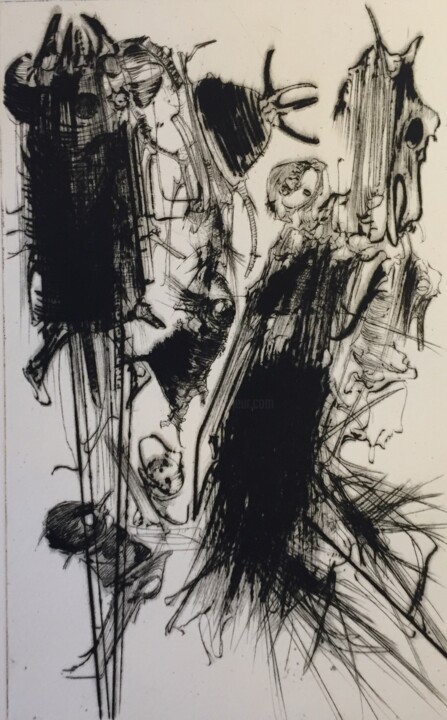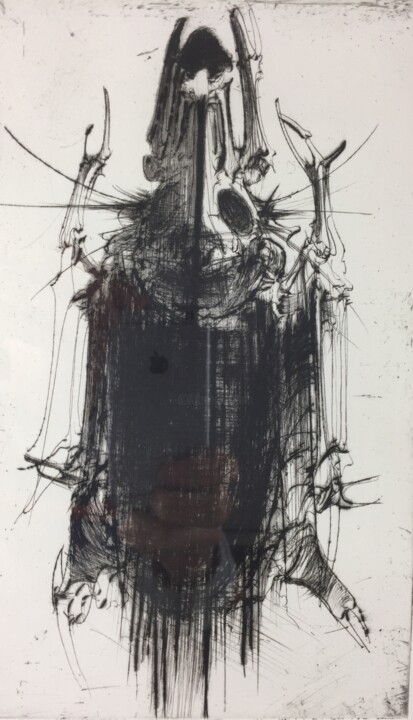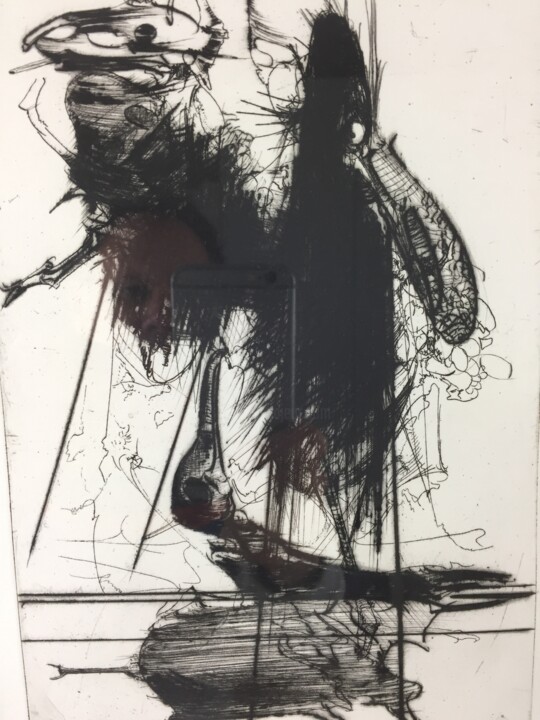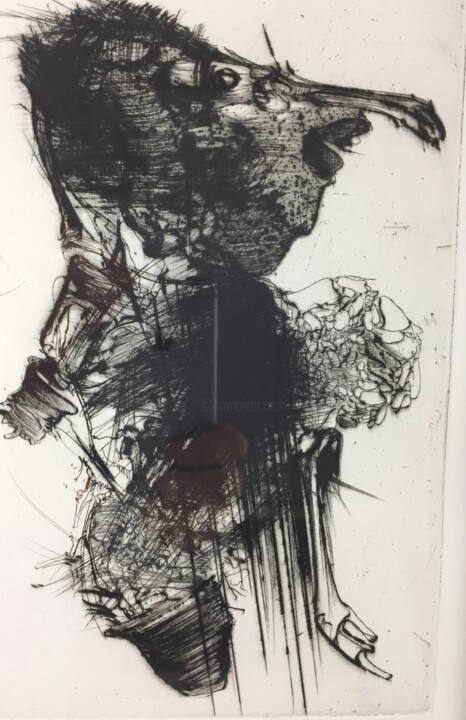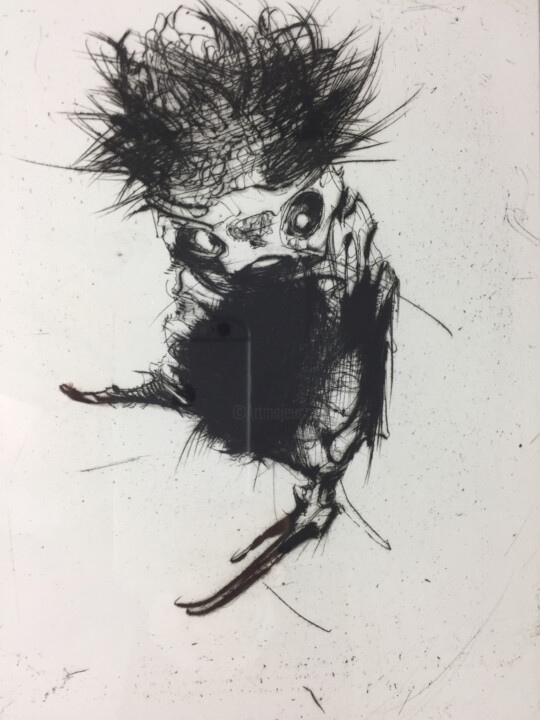 Portrait of the artist Dado Miodrag Djuric, credit: Malcolm DJURIC, via Wikipedia
Portrait of the artist Dado Miodrag Djuric, credit: Malcolm DJURIC, via Wikipedia
Miodrag Đurić, known under the pseudonym Dado, is a Montenegrin artist naturalized French, born in 1933 and died in 2010. Dado is recognized for his unique style which combines surrealism, art brut and free figuration. His works, often marked by themes of violence, monstrosity and imagination, captivate with their intensity and originality.
Dado's originality lies in his eclectic style which combines surrealism, art brut and free figuration, creating an aesthetic that is both disturbing and captivating. His works, marked by themes of violence and monstrosity, use a diversity of innovative techniques and materials, ranging from oil painting to collages and sculptures. Dado's impact on contemporary art is significant: he challenged traditional artistic conventions and influenced many artists with his bold approach and disturbing visions. His work continues to inspire and spark discussions about the limits of art and imagination.
Biography
Childhood and youth
He was born on October 4, 1933 in Cetinje, Montenegro. Coming from a modest family, he grew up in an environment marked by cultural traditions and the political turbulence of the time.
He showed a talent for drawing and painting very early on. He studied at the School of Fine Arts in Herceg Novi where he was influenced by local artistic traditions as well as the works of great European masters. His style began to take shape, incorporating elements of surrealism and art brut.
Installation in France
In 1956, he moved to Paris, the nerve center of modern art. His meeting with Jean Dubuffet, a major figure in art brut, was decisive. Dubuffet recognized the artist's unique talent and encouraged him to continue his artistic explorations.
He quickly joined the School of Paris, a movement bringing together international artists residing in the French capital. This period was marked by intense artistic production and exhibitions which began to make him known to the general public and critics.
Personal and artistic evolution
He married and started a family in France. His personal life, marked by ups and downs, profoundly influences his work, often crossed by themes of suffering and redemption.
The 1960s and 1970s were particularly productive. He has held numerous exhibitions in France and internationally, and his works are increasingly sought after by collectors. His career is punctuated by periods of intense research and questioning, leading him to explore new techniques and new media, always in a quest for renewal and authenticity. He continued to create until his death in 2010 in Pontoise (France).
Dado's Work
The style
He is distinguished by a style that fuses elements of surrealism, art brut and free figuration. His works are marked by dreamlike and grotesque representations, where influences from mythology, history and personal nightmares mingle. His approach is often spontaneous and instinctive, close to art brut, while exploring bold forms and compositions typical of free figuration.
Recurring themes: violence, monstrosity, imagination
The themes of violence and monstrosity are omnipresent in his work. His paintings and drawings often depict scenes of destruction and transformation, populated by hybrid and distorted creatures. Dado's imagination is both fascinating and terrifying, reflecting a worldview of despair and strange beauty.
Techniques and supports used
Painting, drawing, sculpture, engraving
He is a versatile artist who uses various media to express his vision. Painting remains his favorite medium, but he also excels in drawing, sculpture and engraving. Each of these techniques allows him to explore different facets of his imagination and give shape to his inner visions.
Original materials and processes
He does not hesitate to experiment with original materials and processes. He uses mixed media, combining oil paint, ink, collage and various materials to create unique textures and visual effects. This innovative approach allows him to push the limits of traditional artistic expression.
Analysis of some major works
 untitled composition 5, etching, Dado (1990)
untitled composition 5, etching, Dado (1990)
"Untitled Composition 5" (1990) - Etching
The engraving "Composition sans titre5" from 1990 is an etching which presents a scene that is both intriguing and disturbing. Against a mostly white background, an imposing black shape occupies the lower part of the image. This black mass appears to be an amalgamation of dynamic and sharp features, creating a sensation of movement and chaos.
In this black mass, we can distinguish elements evoking fragments of bodies or hybrid creatures. Part of it appears to be a sort of head or skull, with angular shapes that could recall deer antlers or branches. The black lines extending from this central shape give the impression of feathers or scattered hair, adding an organic and disordered dimension to the composition.
A thin horizontal line runs across the engraving, dividing the space into two parts and adding structure to the composition. This line creates a contrast with the entropy of the black mass, accentuating the effect of imbalance and tension.
The use of etching allows him to create marked contrasts between areas of pure white and intense black lines. The fine, precise lines and areas of dense shadow demonstrate the artist's technical mastery and ability to manipulate light and texture to evoke complex emotions.
This engraving by the artist invites a multitude of interpretations. It can be seen as an abstract representation of violence and decomposition, recurring themes in his work. The central black shape could symbolize inner chaos or a threatening presence, in contrast to the surrounding void.
 untitled composition 1, etching, Dado (1990)
untitled composition 1, etching, Dado (1990)
"Untitled composition 1" (1990) - Etching
The engraving "Untitled Composition 1" from 1990 is an etching which presents a strange and disturbing central figure. In the center of the image is a hybrid creature, which appears to be a mixture of human and animal elements.
The creature has a bulky head, with round, expressive eyes. The upper part of the head is topped with dynamic black features that could represent messy hair or feathers. These lines create a dense, chaotic texture, adding to the feeling of unrest.
The creature's body is ovoid in shape, with a dense black texture that contrasts with the white background. The lower limbs, deformed and reminiscent of claws or claws, extend in an angular manner. These appendages contribute to the grotesque appearance of the figure.
The use of etching allows the artist to create fine, precise lines, as well as areas of deep black. The scattered lines and areas of shadow add a dimension of depth and texture to the work. The minimalist composition, with the creature occupying most of the space, heightens the visual and emotional impact of the image.
This engraving invites numerous interpretations. The creature could symbolize aspects of the unconscious, deep fears or troubled emotional states. The juxtaposition of human and animal traits can evoke the duality of human nature and the blurred line between civilization and savagery.
Dado in the Artistic and Cultural Context
Influences and inspirations
Contemporary artists and artistic movements that influenced him
Surrealism
- Salvador Dalí : He was influenced by Dalí's use of dream imagery and surreal landscapes. The distortions of reality and spooky scenes in his works show this influence, with compositions that immerse the viewer in a world of dreams and nightmares.
- Max Ernst : Ernst's collage techniques and strange, unsettling compositions inspired him. He often used mixed media and unexpected juxtapositions to create visually captivating works.
Art Brut
- Jean Dubuffet : The meeting with Dubuffet was decisive for him. Dubuffet, founder of art brut, valued the spontaneous and unconventional expression of self-taught and marginal artists. The impact of this philosophy can be seen in his works, which exhibit a raw intensity and instinctive approach to creation.
- Adolf Wölfli : An emblematic artist of art brut, Wölfli influenced it through his use of repetitive motifs and his complex compositions. His works share this same richness of detail and a certain obsession with filling pictorial space.
Expressionism
- Edvard Munch : The themes of human suffering and anguish in Munch's works had a profound impact on him. Like Munch, he explores intense emotions and dark subjects, using distortion and expressive color palettes to convey powerful feelings.
- Otto Dix : Known for his brutal and realistic depictions of the horrors of war, Dix influenced his portrayal of violence and monstrosity. His engravings show a similarity to Dix's work in terms of themes and graphic treatment.
Cobra Movement
- Karel Appel : The Cobra movement, with its spontaneous and expressive approach, also left an imprint on the artist. Karel Appel's works, characterized by free forms and bright colors, inspired him to experiment with similar techniques to unleash his artistic expression.
- Asger Jorn : A founding member of Cobra, Jorn influenced it with his bold use of color and shape. His works reflect this influence through their visual intensity and raw energy.
Symbolism
- James Ensor : Ensor's works, with their grotesque and carnivalesque scenes, inspired him to incorporate elements of satire and the absurd into his own creations. The use of masks and distorted figures in his works is reminiscent of Ensor's compositions.
- Gustave Moreau : Moreau's use of mythological and allegorical symbols was also echoed in his work, which often incorporated elements of legend and folklore into its complex depictions.
Notable exhibitions:
First personal exhibition at the Galerie Daniel Cordier (1958) :
This first solo exhibition in Paris was a turning point in his career. Organized by the gallery of Daniel Cordier, an important art dealer and collector, it introduced the artist to the Parisian artistic circle and attracted the attention of critics and the public. The exhibited works, marked by violent and dreamlike imagery, caused a sensation.
Exhibition at the Galerie Claude Bernard (1965) :
Another important exhibition in Paris, where he presented a series of new works which strengthened his reputation. The Claude Bernard gallery, known for its support of avant-garde artists, offered the artist a platform to show the evolution of his style and the depth of his imagination.
Retrospective at the Center Georges Pompidou (1985) :
This retrospective at the Center Pompidou was a major event, offering an overview of his work. The exhibition allowed us to rediscover the extent and diversity of his production, from his first engravings to more recent paintings. She confirmed him as a major artist of his time.
Exhibition at the Maeght Foundation (1999) :
The Maeght Foundation in Saint-Paul-de-Vence organized a major exhibition, highlighting his contribution to contemporary art. The exhibition highlighted not only his paintings and prints, but also his works on paper and his sculptures, highlighting the versatility of his talent.
Participation in the Venice Biennale (2001) :
His participation in the Venice Biennale, one of the most prestigious artistic events in the world, marked the international recognition of his work. His exhibited works have been widely commented on by critics, who praised their originality and visual power.
Dado's work, marked by an eclectic style that fuses surrealism, art brut and free figuration, has left an indelible mark on contemporary art. Its recurring themes of violence, monstrosity and imagination, coupled with its innovative techniques and materials, have captivated and disturbed critics and audiences alike. He knew how to challenge artistic conventions and inspire many contemporary artists through his bold approach and his ability to transform inner visions into powerful creations. His legacy continues to resonate, affirming his essential role in the evolution of modern art.


 Jean Dubreil
Jean Dubreil

